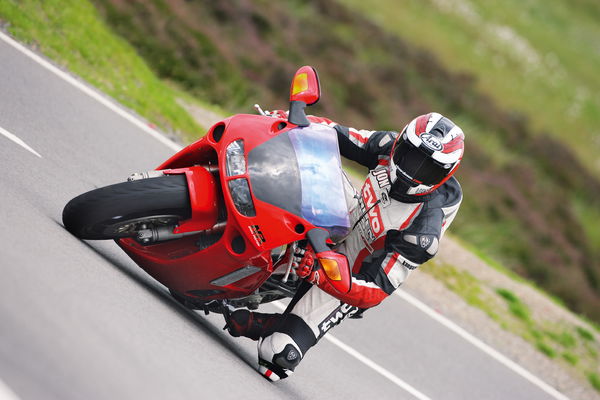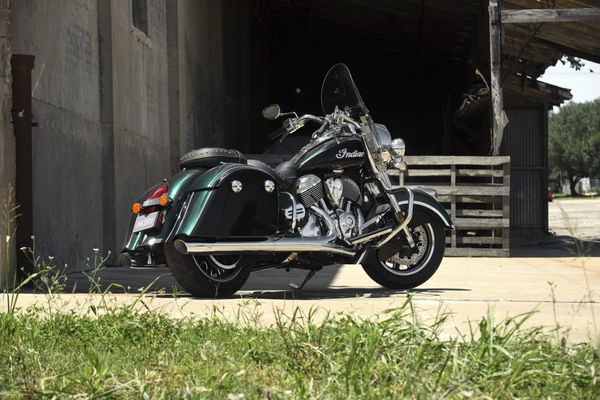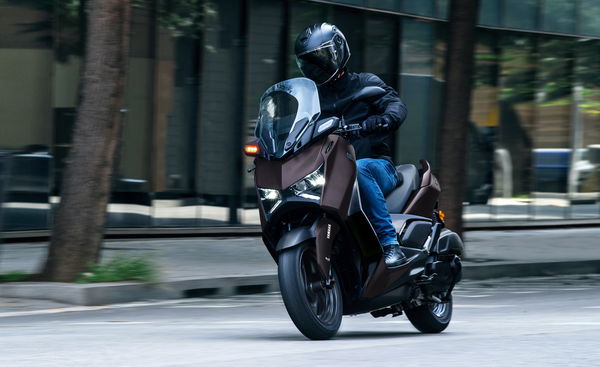Top 10 bikes that broke the ‘rules’
Machines that applied lateral thinking to get an edge on the competition

WHETHER on the racetrack or in the showroom there’s a constant battle for superiority among motorcycle companies. Getting the slightest advantage over your rivals can lead to victory in both areas.
While there’s plenty of merit in simply applying established thinking in a more elegant way than others, a lateral-thinking shortcut is often the best route to getting ahead.
Here are our top 10 machines that interpreted the ‘rules’ – whether those imposed by race organisers or those established in the market place – most creatively.

10: Honda NR series
Whether it’s the original NR500 GP bike that first appeared in 1979 or the ultra-exotic NR750 production model that emerged in 1992, you’ve got to admire Honda’s dedication to alternative thinking. Sure, the NR project was ultimately a failure.
The GP bike wasn’t a winner and the road model, though gorgeous, offered little to justify its insane price tag. But has another company ever dedicated such resources, time and money to such a wonderful folly?
Of course, the key NR concept was the application of oval pistons, each with two con-rods and sitting in cylinders that hosted eight valves. Creating a workable oval piston ring was an incredible challenge, but once done it meant Honda had a V4 engine that operated, to all intents and purposes, as a V8. And all because racing rules at the time didn’t allow more than four cylinders. In theory, the idea would give more revs and more power than a conventional four-stroke V4. In reality, it was just much easier and more effective to use a two-stroke. But as an engineering project, the oval-pistoned NRs were unparalleled.
At the turn of the millennium, the four-stroke MotoGP series that was set to start in 2001 was the biggest talking point in motorcycling. It had been decades since we’d seen companies try to create the ultimate, prototype four-stroke race bikes, and there was a huge question over what they’d come up with. With a set of rules that applied different minimum weights depending on the bike’s cylinder count, we all wondered whether two, three, four or even six cylinders would be the best solution.
Nobody was expecting a five-cylinder racer, though.
Honda’s stroke of genius was simply a careful perusal of the rulebook. Those early MotoGP regulations weren’t written with five-cylinder engines in mind, so they had the same minimum weight as fours. The extra cylinder, combined with some very clever engineering to get around the imbalances that it brought, created a machine that was basically unbeatable in its initial form.
The next set of rule tweaks added a specific, increased five-cylinder minimum weight. Later still, the cylinder count was capped at four (as it had been in the two-stroke era), leading to the conformity of design that we have today.
While Piaggio’s leaning three-wheeled MP3 scooter was an innovation on its own – with clever front suspension to mimic the behaviour of a two-wheeler but adding more stability and grip – it was the LT version that was particularly clever.
Why? Because it increased the ‘track’ (the distance between the centre of the two front wheels’ contact patches) by 45mm, taking it to 465mm. And under European type-approval rules, that transformed the MP3LT from a ‘motorcycle’ to a ‘tricycle’. In turn, that means you only need a car driving licence, not a motorcycle licence, to ride it. Given the vast number of car licence holders compared to bike licensees, the ‘LT’ opened a far bigger potential market.
The loophole was closed in 2013, with rule changes meaning that new licence holders would need a bike licence to operate tricycles. However, anyone with a car licence granted in 2012 or before is still allowed to ride one without needing to take a bike test.
Back in 1986, the ‘1000cc’ superbike class that we know today didn’t exist. Back then, 750cc was the limit for most types of racing, and Suzuki had just introduced the world’s first modern superbike in the form of the GSX-R750. So the decision to build a crazy, 1052cc (later 1127cc) oil-cooled four-cylinder machine with a similar aluminium chassis was a real revolution.
Yes, we tend to see GSX-R1100s as heavy old trucks these days, but that’s only because later rivals (which soon established the 1000cc class that was eventually adopted in production-based racing) advanced the category so quickly.
Why Ducati remains the only bike firm to exploit the advantages of desmodromic valve gear is one of the enduring mysteries of motorcycling. The idea itself far predates Ducati’s use, so the Italian company can’t be credited with its innovation, but no other company has championed the idea so strongly.
Desmo systems – which use additional cam lobes and rockers to close the valves as well as open them – are a little heavier and more complex than conventional, sprung valves. But they completely eliminate the issue of valve float, allowing for increased revs, and they don’t have the same friction as a sprung valve arrangement. The result? Ducatis are almost always more powerful than their similarly-configured rivals.
Getting an edge in the oh-so-competitive 600cc supersports category is notoriously difficult. The machines in the class are incredibly closely matched, employing every engineering trick to extract the maximum performance that the 600cc, four-cylinder format will allow. Kawasaki was dropping a little behind when it struck the simple idea of just ignoring that capacity restriction in 2003. The resulting 636cc machine could edge the competition in power and torque, while stressing the engine less and at no appreciable increase in the bike’s weight.
The racing class was catered for by the downsized ZX-6RR, which had a 599cc version of the engine.
Why Kawasaki’s rivals never copied the idea remains a mystery.
Ducati’s new V4 superbike has left jaws on the floor across the world with a seemingly impossible combination of power, torque and rideability. Some of that’s down to the Desmo valves and insanely clever electronics, but a big portion comes to the simple fact that while everyone else concerns themselves with the 1000cc limit imposed by WSB racing, Ducati has built an 1103cc four-cylinder superbike. That’s a scooter’s-worth more than any of its competitors, and makes beating them in sheer performance a simple job.
Of course a homologation-special, sub-1000cc version is due to come later this year to make the V4 race-legal.
Ducati pulled a similar trick with the last of the V-twin Panigales. At 1285cc it was too big for the 1200cc V-twin racing limit. But with no appreciable road-going V-twin superbike rivals, it was hard to judge the real value of those extra cubes. The new V4 makes it clear that their value is simply enormous.
If others don’t copy this idea, we’ll be amazed.
What’s so clever about the latest GSX-R1000? It’s the variable valve timing system. No, it’s not the first bike to have one, but it’s the first to cunningly circumvent racing rules that bar the use of ‘hydraulic or electronic’ VVT. In fact, the GSX-R’s purely-mechanical variable valve timing, which uses centrifugal force to govern the advancing intake cam timing as revs rise, was first developed for the GSX-RR MotoGP bike precisely because conventional VVT is banned in that series.
The result? A better spread of power and torque than you’d get with fixed valve timing, as well as improved emissions, which are a huge bonus for the road-going machine.
When it comes to playing silly buggers with engine capacity rules in racing, we’ve already seen several examples in this list. But Norton’s use of a Wankel rotary engine is unparalleled.
The problem is that, because of the way Wankels work, it’s basically impossible to compare their capacity to conventional, reciprocating two- and four-stroke engines. Even the very job of measuring a Wankel’s volumetric capacity is hard – the Norton was nominally 588cc – because it works in such a completely alien way.
Norton’s real achievement with its late-80s and early-90s rotaries was getting racing authorities to accept them at all. Not only did the bike race in BSB – winning the 1994 title – but in the TT (winning the Senior with Hislop in 1992) and even in the 1991 British GP, where Ron Haslam took one to 12th place. Basically, Norton confounded the rule-makers by submitting a bike with an engine that just couldn’t be compared to more established designs.
One can only imagine how successful rotaries would have been had a well-funded, major manufacturer pursued the idea in a similarly dogged fashion.
Yes, we’ve seen that bucking capacity classes is a proven way to get a leg up against the competition, but surely it’s never been done so successfully as with the original 893cc Honda FireBlade in 1992.
The Blade actually started life as a reject. Honda developed it as a 750cc inline four, based vaguely on the little-known CBR750F Hurricane, as an alternative option to the V4 race bike project that would become the RC30. It never reached production in that form but was revived when Tadeo Baba legendarily came up with the idea of boosting its capacity. By completely ignoring the race classes of the time, he was able to come up with a road-only superbike that was vastly better than any of its rivals. As light as the 750 it was originally conceived as, it had power that was close to that of period 1000cc machines that were vastly heavier.
We’re unlikely to ever see a superbike that gets such a big advantage over its competitors, but Ducati’s new Panigale V4 shows that Baba’s 25-year-old idea can still be applied with devastating effect.











